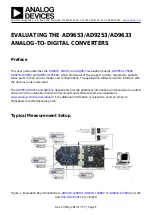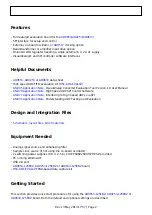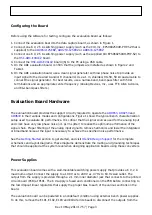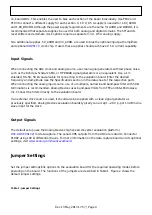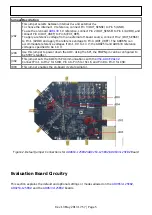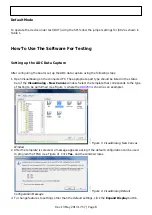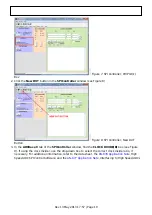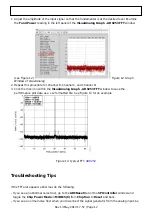
Rev 13 May 2013 17:57 | Page 3
Configuring the Board
Before using the software for testing, configure the evaluation board as follows:
Connect the evaluation board to the data capture board, as shown in Figure 1.
1.
Connect one 6 V, 2.5 A switching power supply (such as the CUI, Inc., EPS060250UH-PHP-SZ that is
2.
.
Connect one 6 V, 2.5 A switching power supply (such as the supplied CUI EPS060250UH-PHP-SZ) to
3.
board.
board (J6) to the PC using a USB cable.
4.
On the ADC evaluation board, confirm that the jumpers are installed as shown in Figure 2 and
5.
Table 1.
On the ADC evaluation board, use a clean signal generator with low phase noise to provide an
6.
input signal to the desired A and/or B channel(s). Use a 1 m, shielded, RG-58, 50 Ω coaxial cable to
connect the signal generator. For best results, use a narrow-band, band-pass filter with 50 Ω
terminations and an appropriate center frequency. (Analog Devices, Inc., uses TTE, Allen Avionics,
and K&L band-pass filters.)
Evaluation Board Hardware
The evaluation board provides the support circuitry required to operate the
and
in their various modes and configurations. Figure 1 shows the typical bench characterization
setup used to evaluate AC performance. It is critical that the signal sources used for the analog input
and clock have very low phase noise (<1 ps rms jitter) to realize the optimum performance of the
signal chain. Proper filtering of the analog input signal to remove harmonics and lower the integrated
or broadband noise at the input is necessary to achieve the specified noise performance.
section to get started, and visit
schematics and layout diagrams. These diagrams demonstrate the routing and grounding techniques
that should be applied at the system level when designing application boards using these converters.
Power Supplies
This evaluation board comes with a wall-mountable switching power supply that provides a 6 V, 2 A
maximum output. Connect the supply to a 100 V ac to 240 V ac, 47 Hz to 63 Hz wall outlet. The
output from the supply is provided through a 2.1 mm inner diameter jack that connects to the printed
circuit board (PCB) at P101. The 6 V supply is fused and conditioned on the PCB before connecting to
the low dropout linear regulators that supply the proper bias to each of the various sections on the
board.
The evaluation board can be powered in a nondefault condition using external bench power supplies.
To do this, remove the E101, E102, E103 and E104 ferrite beads to disconnect the outputs from the

